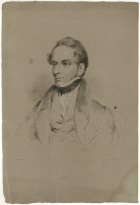Decimus Burton, son of James Haliburton and Elizabeth Haliburton [Westley]
 © National Portrait Gallery
© National Portrait GalleryDecimus Burton was born on 30th September 1800 in the parish of St Pancras, London, and christened in Old Church, St Pancras on 18th July 1802, the tenth son of James Haliburton and his wife, Elizabeth (nee Westley). James Haliburton, later Burton, (1761-1837) was one of the most significant builders of Georgian London, responsible for large areas of Bloomsbury, as well as St. Johns Wood and Clapham Common and, in collaboration with John Nash, the development of Regents Park. In 1828 he started building a new seaside town at St. Leonards near Hastings based closely on his experiences at Regents Park. The first four children were christened Haliburton but from 1794 onwards the remaining six children were all christened as Burton. The fourth child, James Haliburton (1788 - 1862), was to have an eminent career as an Egyptologist. After the birth of their last child, Jesse, in 1804, the family moved to Mabledon, Quarry Hill, Tonbridge and Decimus Burton was educated at Tonbridge School followed by several years in the Royal Academy Schools in Somerset House where Sir John Soane was Professor of Architecture.
Through his father's connections, Decimus gained many early commisions in Regents Park in London (including the family residence at The Holme) before gaining the design for his first major public building at the Colosseum in 1823, followed by the Ionic Screen at Hyde Park Corner in 1825, the Wellington Arch at Hyde Park Corner in 1826, Cornwall Terrace in Regents Park, the Athenaeum Club in Pall Mall and Trinity Church, Tunbridge Wells in 1827, Charing Cross Hospital in 1831, Fleetwood, Lancashire in 1836, and, later in 1846, The Palm House at Kew. In 1850 Decimus began the second phase of building at St Leonards on Sea, originally, commenced by his father
In 1826, the 870 acreage Calverley Estate was acquired by John Ward J.P., M.P. (1776-1855). He commisioned Decimus Burton "to erect a number of edifices suitable to the reception of genteel families, and simultaneously with the larger buildings, a number of shops, etc in their immediate neighbourhood, so that residents upon the estate might enjoy the same advantages as those who lived nearer the Springs." By 1839 all the Calverley Park villas were complete and Decimus Burton had taken possesion of No 4. In that same year the Calverley House (previously Mount Pleasant House) had been extensively refurbished and extended by Decimus Burton. In the years that followed his commisions in Tunbridge Wells and the surrounding area were extensive and included The Grove at Penshurst, Burrswood at Groombridge, Bentham Hill and St Peters Church at Southborough, Hollands at Langton Green and St Marys Church at Riverhead.
In 1832 Decimus Burton was elected a Fellow of the Royal Society and he continued in practice until 1869. In his later years, he spent his time as a lifelong batchelor between his properties at Gloucester Gardens, Hyde Park and St Leonards in Sussex. He died on 14th December 1881 in his home in London and is buried at Kensal Green cemetery.
For more information about James and Decimus Burton see the Hastings Museum web site
See also

Date
Type
Information
Source
30th Sep 1800
Born
London
Hastings Museum
18th Jul 1802
Christened
At St. Pancras Old Church, in London
IGI - Family Search
14th Dec 1881
Died
At 1 Gloucester Houses, Kensington, in London
Hastings Museum
after 14th Dec 1881
Buried
At Kensal Green Cemetery, in London
Hastings Museum
16th Feb 1882
Probate
At Principal registry in the County of Middlesex; Personal estate: £57,957 3s 3d
Probate Registry of England and Wales
17th Aug 1827
History
Colbran's Tunbridge Wells
… the first stone was laid on the Duchess of Kent's birth-day, the 17th August, 1827. The building was completed in about two years, and on the 3rd. September, 1829, it was consecrated, with the accustomed ceremonies, by the Bishop of Rochester … The Church, called "Holy Trinity," is a handsome structure in the style of the thirteenth and fourteenth centuries, and is seen to great advantage from many parts of the common. Decimus Burton, Esq. was the Architect, and Messrs. Barrett, of Tunbridge Wells, were the Builders. It cost upwards of £12,000., although the stone used in the building was procured from the Calverley quarry, in the immediate neighbourhood of the church.
1829
History
Colbran's Tunbridge Wells
[Starting in 1829] the most important alterations were commenced that the Wells had yet seen. These were made on the Calverley Estate which is the property of John Ward, Esq. of Holwood, in the County of Kent. This gentleman having purchased the Calverley and other considerable property adjoining it, … determined upon erecting a number of edifices suitable to the reception of genteel families; and simultaneously with the larger buildings, a number of shops, &c. in their immediate neighbourhood, so that the residents upon this estate might enjoy the same advantages as those who lived nearer the Springs. In the autumn of 1828, this extensive undertaking was commenced from the designs of Decimus Burton, Esq. the eminent Architect of Spring Garden, London; the Messrs. Bramah, of Pimlico, having taken the ground necessary for the purpose, on a building lease. As these buildings progressed, it was evident that a new town was springing up - villas, a terrace, a parade, rows of shops, &c. soon began to develope themselves, and advanced steadily to completion.
Calverley Park comprises 26 acres, adjoining to and overlooking 20 acres of meadow and pleasure grounds in front of the Hotel, and contains twenty-four villas, chiefly of the Italian and Grecian style of architecture. The elegant appearance of these buildings attracts attention and excites admiration; and the views from the Park are at once extensive, diversified, and beautiful; equal, if not superior, to any at the Wells.
At the north west side of the park, is Calverley Promenade, built in the form of a crescent. This row of buildings (seventeen in number) was originally intended for shops, but within the last two years several of them have been converted into dwelling-houses. At one end of the promenade there are Shampooing and Vapour Baths; in the centre, a Library, Reading Room, &c., opposite to which is a Fountain, and beyond that a temporary Orchestra has been erected, where, in the season, a band is stationed to amuse the company. Immediately adjacent to the promenade is the Calverley Hotel, which has been recently finished; the accommodations here are of the first-rate description, and the situation in which it is placed, commanding as it does an uninterrupted view over delightful scenery, renders it one of the most charming spots in the country.
On the opposite side of the road from the Hotel is Calverley Terrace, consisting of four double Villas with pleasure grounds in front and gardens behind, communicating with the stables, coach-houses, &c. Calverley Parade, immediately adjoining, is a range of twelve houses (which were the first built) on a similar scale to those of the terrace, but smaller; and at the back of these are the Calverley Mews, which afford extensive accommodation for horses and carriages, independent of those which are attached to the houses on the terrace and parade. A short distance from the latter, is an excellent Commercial and Family Hotel, called the Camden; next to which is a Market House, one of the most elegant buildings in Tunbridge Wells. … On a line with this is Calverley Place consisting of twelve houses and shops
1830 to 1840
History
Colbran's Tunbridge Wells
Opposite one of the entrances to the Park is Baston Cottage, an elegant building in the Gothic stile of architecture. It is the property of Decimus Burton, Esq. There are some extensive pleasure grounds here, which are laid out with great taste. Immediately adjacent to Baston cottage, are the Calverley Nursery Grounds, in the occupation of Mr. William Piper, which always afford a most delightful lounge to visitors, and are well worth seeing. The building of the new town appeared to act as a powerful stimulus, for while this was going on the Windmill Fields in the neighbourhood of Calverley were covered with cottages, and much of the adjoining land was also built upon. Several detached villas have been erected, as well as a row of houses, called Park View, pleasantly situated, which command an extensive prospect. Adjoining these is Grove Hill comprising a number of genteel residences and first-rate lodging-houses, which are eagerly sought after during the season.












